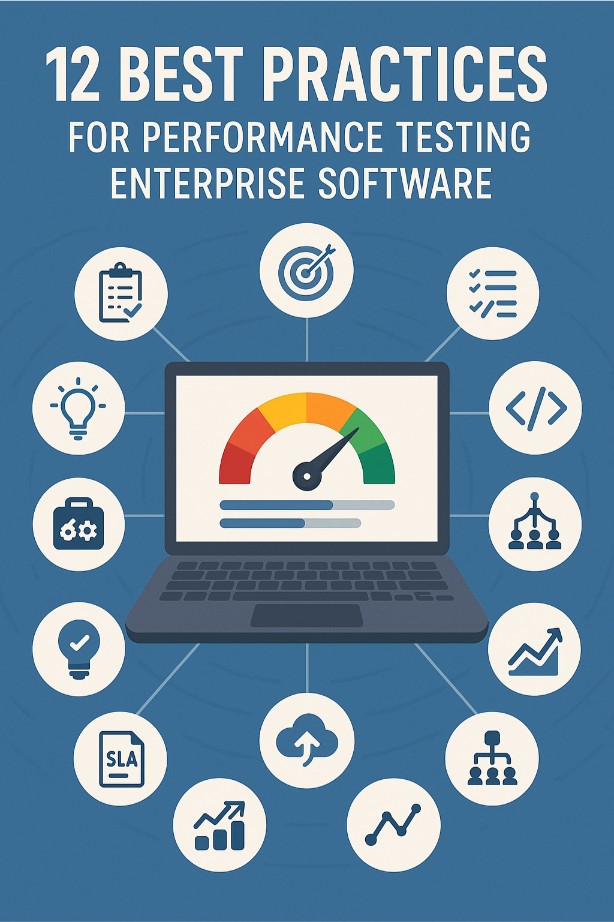Codeless testing is revolutionizing quality assurance by allowing teams to build, execute, and maintain tests without writing a single line of code. This approach minimizes manual scripting, accelerates the testing process, and makes automation accessible to non-developers. Recent statistics indicate that companies leveraging codeless testing have reduced their testing cycle times by up to 35% while increasing test coverage by around 25%. In this article, we compare the top 10 tools, answer common questions about no-code testing, and explain why tools like LoadFocus are leading the market for performance and load testing.
Comparative Summary of Codeless Testing Tools
| Tool | Best For | Key Features | Use Case |
|---|---|---|---|
| LoadFocus | Codeless load testing & performance analysis | Intuitive interface, real-time website speed test, comprehensive API monitoring, integrated synthetic monitoring and visual regression testing | Scalable load and performance assessments |
| Rainforest QA | Codeless functional and regression testing | AI-powered test creation, cloud-based execution, parallel testing, detailed reporting | Web and mobile application testing |
| Testim | Accelerated test automation with minimal scripting | Self-healing tests, visual validation, fast test creation, continuous integration support | Rapid functional testing for dynamic apps |
| Mabl | End-to-end testing without coding | Auto-healing scripts, root-cause analysis, detailed logs, seamless integrations with CI/CD pipelines | Functional and regression testing |
| Leapwork | Automation for repetitive test scenarios | Visual flowchart design, drag-and-drop interface, extensive integrations, reusability of test steps | Enterprise-level test automation |
| Katalon Studio | Comprehensive testing across multiple platforms | Scriptless test creation, robust reporting, cross-browser testing, built-in object repository | Web, API, and mobile test automation |
| Functionize | AI-driven functional testing | Machine learning-powered test creation, continuous testing, adaptive maintenance, visual testing | Complex application testing with minimal setup |
| Appvance IQ | Scalable performance and functional testing | Integrated test design, advanced analytics, real-time dashboards, seamless CI/CD integration | Large-scale enterprise testing |
| Tricentis Tosca | Enterprise-grade, risk-based testing | Model-based test automation, risk-based testing, extensive integrations, robust test data management | End-to-end enterprise testing |
| Selenium IDE | Quick record-and-playback testing | Browser-based test recording, easy editing, exportable test scripts, community support | Small projects and prototyping in web testing |
Top 10 Codeless Testing Tools to Try
1. LoadFocus
Category: Codeless Load & Performance Testing
Overview:
LoadFocus is a market-leading tool offering a comprehensive, codeless approach to load and performance testing. With an intuitive interface and real-time analytics, it empowers teams to simulate realistic user loads without the complexities of traditional scripting. LoadFocus integrates advanced features like a website speed test and API monitoring to ensure your application performs optimally under pressure.
Is Your Infrastructure Ready for Global Traffic Spikes?
Unexpected load surges can disrupt your services. With LoadFocus’s cutting-edge Load Testing solutions, simulate real-world traffic from multiple global locations in a single test. Our advanced engine dynamically upscales and downscales virtual users in real time, delivering comprehensive reports that empower you to identify and resolve performance bottlenecks before they affect your users.
Key Features:
- Intuitive, drag-and-drop interface
- Real-time reporting and analytics
- Integrated synthetic monitoring and visual regression testing
- Scalable cloud-based execution
- Detailed load testing reports
Pros:
- Easy-to-use even for non-developers
- Robust performance analysis tools
- Seamless integration with CI/CD workflows
Cons:
Think your website can handle a traffic spike?
Fair enough, but why leave it to chance? Uncover your website’s true limits with LoadFocus’s cloud-based Load Testing for Web Apps, Websites, and APIs. Avoid the risk of costly downtimes and missed opportunities—find out before your users do!
- Primarily focused on performance and load testing
- May require additional tools for comprehensive functional testing
Use Case:
Ideal for teams needing to assess application performance and scalability without complex scripting.
Pricing:
Offers a flexible, usage-based model with a free load test option to get started.
2. Rainforest QA
Category: Codeless Functional & Regression Testing
Overview:
Rainforest QA leverages AI to simplify test creation and execution. Its cloud-based platform allows users to run parallel tests across various environments with minimal setup.
Key Features:
LoadFocus is an all-in-one Cloud Testing Platform for Websites and APIs for Load Testing, Apache JMeter Load Testing, Page Speed Monitoring and API Monitoring!
- AI-driven test generation
- Cloud execution and parallel testing
- Detailed and easy-to-understand reports
Pros:
- Fast test creation
- Scalable solution for modern applications
- No coding required
Cons:
- May not cover advanced performance testing needs
Use Case:
Best suited for teams focused on functional and regression testing for web and mobile applications.
3. Testim
Category: Accelerated Test Automation
Overview:
Testim offers a smart testing platform that uses machine learning to improve test stability and reduce maintenance overhead.
Key Features:
- Self-healing tests
- Visual test creation and validation
- Fast integration with CI/CD pipelines
Pros:
- Reduces manual test maintenance
- Quick and efficient test creation
- Intuitive user interface
Cons:
- Primarily focused on functional testing
- May require a learning curve for advanced features
Use Case:
Great for agile teams looking to quickly build and run functional tests with minimal scripting.
4. Mabl
Category: End-to-End Test Automation
Overview:
Mabl is a cloud-based testing platform that automates functional and regression testing with minimal manual intervention.
Key Features:
- Auto-healing test scripts
- Comprehensive logs and root-cause analysis
- Seamless CI/CD integration
Pros:
- High accuracy in test maintenance
- Easy to integrate into existing workflows
- Supports a wide range of application types
Cons:
- Focuses mainly on functional testing
- May not offer extensive performance testing features
Use Case:
Ideal for teams seeking continuous and automated functional testing without complex scripting.
5. Leapwork
Category: Automation for Repetitive Scenarios
Overview:
Leapwork simplifies automation with a visual flowchart design, making it accessible for non-technical users while maintaining enterprise-level capabilities.
Key Features:
- Drag-and-drop interface
- Reusable test steps and flows
- Extensive integration options
Pros:
- No coding required
- Easy maintenance of test flows
- Suitable for large-scale automation
Cons:
- May not support very complex testing scenarios
- Limited in performance testing capabilities
Use Case:
Best for enterprises automating repetitive, data-driven testing processes.
6. Katalon Studio
Category: Comprehensive Multi-Platform Testing
Overview:
Katalon Studio provides a unified platform for web, API, and mobile testing. Its codeless mode empowers teams to create robust test cases through an intuitive interface.
Key Features:
- Record and playback capabilities
- Integrated object repository
- Cross-browser testing support
Pros:
- Versatile and comprehensive
- Community and enterprise editions available
- Supports various testing types
Cons:
- Advanced features may require some scripting
- The interface can be overwhelming for new users
Use Case:
Ideal for teams requiring an all-in-one testing solution across multiple platforms.
7. Functionize
Category: AI-Driven Functional Testing
Overview:
Functionize uses machine learning to create and maintain tests, allowing for rapid adaptation to application changes without manual rework.
Key Features:
- AI-powered test creation
- Real-time test maintenance
- Advanced analytics and reporting
Pros:
- Reduces maintenance overhead
- Quick adaptation to changes
- High accuracy in test results
Cons:
- May be cost-prohibitive for smaller teams
- Focused primarily on functional testing
Use Case:
Suited for complex application environments where continuous testing is crucial.
8. Appvance IQ
Category: Scalable Performance & Functional Testing
Overview:
Appvance IQ integrates both performance and functional testing in one platform. Its unified approach helps teams streamline their testing efforts across multiple dimensions.
Key Features:
- End-to-end test design
- Real-time dashboards and analytics
- Seamless CI/CD integration
Pros:
- Versatile testing capabilities
- Strong enterprise support
- Comprehensive analytics
Cons:
- May require a higher learning curve
- More suitable for larger organizations
Use Case:
Ideal for enterprises looking for a scalable solution that covers both functional and performance testing.
9. Tricentis Tosca
Category: Enterprise-Grade Risk-Based Testing
Overview:
Tricentis Tosca is a robust tool designed for high-volume, enterprise-level test automation. Its model-based approach simplifies the creation and maintenance of complex test scenarios.
Key Features:
- Model-based test automation
- Risk-based testing methodology
- Extensive integration capabilities
Pros:
- Highly scalable for large organizations
- Comprehensive test management features
- Proven track record in enterprise environments
Cons:
- Expensive compared to other solutions
- Steep learning curve for new users
Use Case:
Best suited for enterprises that require thorough, risk-based test automation.
10. Selenium IDE
Category: Record-and-Playback Testing
Overview:
Selenium IDE offers a quick and simple way to record and playback tests in the browser. It is ideal for small projects and prototyping where full-scale automation is not required.
Key Features:
- Browser-based test recording
- Easy-to-use interface
- Exportable test scripts
Pros:
- Free and open-source
- Quick to set up
- Ideal for beginners
Cons:
- Limited functionality for complex scenarios
- Not designed for large-scale testing
Use Case:
Perfect for small projects or initial prototyping of test cases.
FAQs
What is no-code testing?
No-code testing refers to the practice of creating and executing tests using graphical interfaces and pre-built functions without the need for manual coding. It democratizes test automation by making it accessible to non-technical users.
Which testing does not require coding?
Codeless or no-code testing is designed to eliminate the need for scripting. Tools like LoadFocus offer an intuitive interface where tests can be created through drag-and-drop features, removing the barrier of coding entirely.
Can I do automation testing without coding?
Yes, many modern testing tools provide codeless solutions that allow you to automate tests through visual interfaces and record-and-playback functionalities. These platforms are designed to simplify the testing process for users without coding expertise.
What are 4 types of testing in programming?
Common types include:
- Functional Testing: Validates the software’s functionality.
- Performance Testing: Assesses speed, scalability, and stability.
- Security Testing: Checks for vulnerabilities.
- Usability Testing: Evaluates user experience.
What is the difference between codeless and no-code?
While both terms imply testing without traditional scripting, “codeless” often refers specifically to tools that simplify test creation through visual elements, whereas “no-code” may also encompass broader software development practices that require no programming.
What does no coding mean?
No coding means achieving objectives or automating processes without writing any manual code. In testing, this is accomplished through user-friendly interfaces that allow you to design tests with simple drag-and-drop actions.
Is no-code better than coding?
No-code testing is ideal for speeding up test creation and making automation accessible to a broader audience. However, it may not offer the same level of flexibility and customization as traditional coding-based approaches. The choice depends on your team’s expertise and the project’s complexity.

![9 Best IT Incident Management Software [2025] 9 Best IT Incident Management Software [2025]](https://loadfocus.com/blog/wp-content/uploads/sites/5/2024/08/it-management-tools.jpg)



